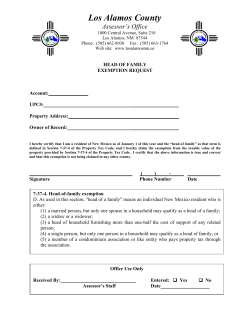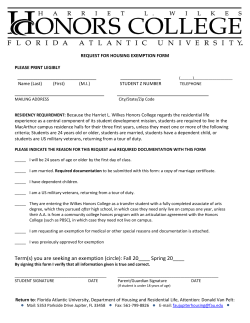
Notification of the regionally differentiated social security
Case handler: Christian Jordal
Tel: (+32)(0)2 286 1889
Brussels, 15 October 2015
cjo@eftasurv.int
Document No: 776348
Case No: 78043
Ministry of Trade, Industry and Fisheries
P.O. Box 8090 Dep
0032 Oslo
Norway
Subject:
Notification of the regionally differentiated social security
contributions schem e 201 4-2020
Request for additional information pursuant to Article 5(l) of Part II of
Protocol 3 to the Agreement between the EFTA States on the
Establishment of a Surveillance Authority and a Court of Justice
The EFTA Surveillance Authority (the Authority) refers to the judgment of the EFTA
Court of 23 September 2015 partially annulling the Authority's Decision No 225ll4lCOL
("the Decision").
most recently in the Oslo state aid package meeting on 8
the Court's partial annulment entails that the Authority must re-assess the
As previously discussed
-
October 2015 part of the Decision that was annulled.
In its judgment, the Court identified the "main rule" of the
scheme from which
distinguished an'oexemption rule":
Under the main rule, employers with registered business activity within the remote
geographical areas covered by the scheme, such as Finnmark, are automatically
entitled to a reduced rate ofsocial security contribution rate.
By way of exemption from that main rule, the scheme is also applied to employers
registered outside the regional aid area if they post or hire out workers to the eligible
area. For a worker employed by a company registered in Oslo (where the normal
l4.l% rate applies) carrying out work in Finnmark (where alYorate applies), it is
then the 0% Finnmark-rate that applies.
According to the wording of the operative part of the judgment, the Court annulled the
Decision "in so far as it closed the preliminary investigation as regards section l(4) of the
Norwegian Parliament's Decision No 1482 of 5 December 2013 on determination of the
tax rates etc. under the National Insurance Act for 2014".
The provision referred to by the Court provides for the exemption rule and it is clear that
the annulment squarely applies to that rule.
The same provision is however drafted in such a way as to conflate, together with the
exemption rule, an "anti-circumvention rule" designed to prevent undertakings from
claiming aid under the scheme by virtue of simply registering their business within the
eligible area, even if they then proceed to post or hire out their employees to work outside
Rue Belliard 35, B-1040 Brussels, tel: (+32X0)2 286
l8 I I'
fax: (+32X0)2286 18 00, rvurv.eftasun'.int
Page2
the eligible area. In the absence of this anti-circumvention rule, it is clear that additional
amounts of aid would be payable. In the absence of the anti-circumvention rule, a
company could, for example, benefit from the 0% Finnmark social security rate by
registering its business there, even if its workers are actually posted in Oslo.
Therefore, although the anti-circumvention rule is conflated with the exemption rule in the
provision mentioned in the operative part of the Court's judgment, the Authority has
serious doubts that the Court intended to annul its approval of the anti-circumvention rule.
There are moreover a number of procedural grounds comforting the Authority in its view,
notably the fact that the anti-circumvention rule was not the subject of the successful
application and was not expressly identified by the Court in its judgment. The Authority
however notes that Kimek Offshore AS has made it known that it disagrees with the
Authority's view on this point and considers that the Authority's approval of the anticircumvention rule was annulled by the judgment. To obtain legal certainty on the issue,
the Authority intends to lodge an application for interpretation of the judgment in
accordance with Article 95 of the Rules of Procedure of the EFTA Court.
In keeping with the above, it is the view of the Authority that the Norwegian authorities
must suspend, as soon as possible, the application of the exemption rule. The suspension
must remain in force at least until the Authority has adopted a final decision on the
compatibility with the frrnctioning of the EEA Agreement of that rule.
As the Authority currently, on the basis of the notification information, has insufficient
information on the actual implications of the exemption rule, it hereby invites the
Norwegian authorities to provide more information on the functioning of the rule. The
Norwegian authorities are also invited to put forward its arguments as to why that rule
should be found compatible with the functioning of the EEA Agreement. Without this
information, the Authority is unable to properly assess the compatibility of the exemption
rule with the provisions of the EEA Agreement. Consequently, the period of two months
within which it is required to do so will only start after the additional information is
received.
The information requested in this letter should reach the Authority by 6 November 2015.
Yours faithfully,
Director
Competition and State Aid Directorate
© Copyright 2025











